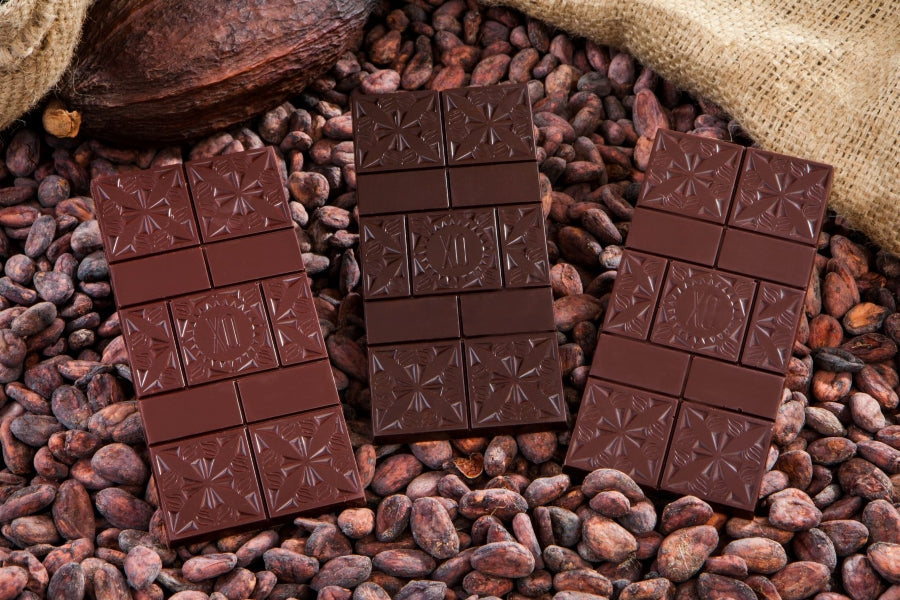
Just this month, Oprah (yes, the one and only Oprah) and Condé Nast Traveler both featured our single-origin chocolate in their best-of lists. A few days ago, The Washington Post published an article encouraging milk chocolate-loving readers to try single-origin chocolates as they transition toward healthier dark chocolate. If it seems counterintuitive that some of the most flavorful and exciting chocolate currently being made is unflavored “plain” dark chocolate, you must let me introduce you to the surprises and epicurean joys of single-origin chocolate.
First off, what exactly is single-origin chocolate?
In general terms, single-origin chocolate refers to chocolate made from cacao beans that were grown within the same country and not mixed with cacao from other countries. From a craft chocolate maker’s perspective, using cacao that is of similar taste and size from one origin throughout the whole batch of chocolate creates an opportunity to tease out a flavor profile that expresses the inherent, and often unexpected, flavor characteristics of that unique cacao origin.
 The cacao pod’s coloration, smoothness, bumpiness, length, overall shape, and pointiness or dullness of the tip and neck are clues to identifying the genetic variety of cacao grown in different regions.
The cacao pod’s coloration, smoothness, bumpiness, length, overall shape, and pointiness or dullness of the tip and neck are clues to identifying the genetic variety of cacao grown in different regions.
In contrast, and from an industrial chocolate perspective, mixing together different cacao varieties from different origin countries and applying the exact same processing steps for every vat of chocolate regardless of the types of cacao sourced, allows for far easier mass production of chocolate, with the intent of yielding only one uniform flavor across the whole product line.
 The difference in taste between cacao varieties can be as noticeable as the difference in taste between a Granny Smith apple and a Red Delicious.
The difference in taste between cacao varieties can be as noticeable as the difference in taste between a Granny Smith apple and a Red Delicious.
When we use the term single-origin for our chocolate, we are referring to chocolate made from cacao beans sourced from one particular region of one country, usually within natural topographical boundaries, increasing the specificity of the origin. By shrinking the geographic size of the origin, we are able to zero in on cacao that, while grown by multiple farmers who neighbor each other, were grown and harvested in a similar environment (climate, weather, soil) and were likely centrally fermented and sun-dried in a similar manner, leading to consistency in flavor and quality within that region. Optimally, cacao will taste true to form within an origin and also uniquely different from any other origin.

Fine-flavor and heirloom cacao varieties tend to grow best in healthy, shaded forests. Protecting the world’s rainforests can have the added effect of conserving biodiversity in cacao and variety in chocolate flavor.
Single-origin chocolate is made with minimal ingredients (some makers create single-origin milk chocolate, but it is more frequently made as dark chocolate) in order to really highlight the flavor of the origin. With no added flavor ingredients to hide under, this type of “plain” dark chocolate is meant to showcase the complex, widely varying, and sometimes totally wild flavors that exist on the dark chocolate flavor spectrum. In our case, our flavor-inclusions line of chocolate bars are fun to make (I mean, who doesn’t love nuts and sea salt and coffee in their chocolate?), but our meticulous hearts focus on our single-origin chocolate bar line and we’re proud that the very first chocolate award we won (ecstatically) was for our single-origin bar from Peru.
Okay, just how “wild” are we talking?
Since I sadly can’t share chocolate samples through a screen, you’ll need to let your imaginations color your appetite for this part. Keep in mind that taste is 100% subjective (and often suggestive) and if you were able to take some outstretched samples through your screen, your tasting notes might be very different from mine. Even if that is the case, I’m pretty sure you will surprise yourself with what you taste. Here are just some examples of the breadth of the chocolate flavor spectrum, pulling from just 4 origins we currently source from.
 First, though, think back to this candy as your baseline expectation of what dark chocolate tastes like. Even if it’s been a while since you’ve had one of these, this product set the expectations for most of us about the flavor of dark chocolate.
First, though, think back to this candy as your baseline expectation of what dark chocolate tastes like. Even if it’s been a while since you’ve had one of these, this product set the expectations for most of us about the flavor of dark chocolate.

Now, our San Martin de Pangoa, Peru single-origin bar, made of just 70% cacao and 30% cane sugar (cacao grown in the Upper Amazon of Peru).
We taste flavors of jammy dark berries, hibiscus, and baking spices. Occasionally a raisiny flavor jumps in to say hi. Medium acidity, low tannins, and a long finish.
Our Matagalpa, Nicaragua single-origin bar, made of 72% cacao and 28% cane sugar (cacao grown in the coffee-growing highlands of central Nicaragua).
We taste subtle floral flavors like lilies; also coffee and sometimes olive. Tannic like leather aromas and black tea, low acidity with a medium-length finish.

Our Kilombero Valley, Tanzania single-origin bar, made of 73% cacao and 27% cane sugar (cacao grown in eastern Tanzania).
We taste tart red berries and tangy lactic flavors, which remind us of a raspberry cheesecake. High acidity, high complexity and will occasionally hit a green apple note.
Our Semuliki Forest, Uganda, single-origin bar, made of 75% cacao and 25% cane sugar (grown on the far western border of Uganda).
We primarily taste bold cocoa but underneath that nostalgic flavor, we get walnut, cardamom, and every once in a while, an appearance from orange marmalade.
You’ll notice slight variations in the percentage of cacao and cane sugar in the bars above, but all are between 70% and 75% cacao content, and the variations in flavor are not as much dictated by the sugar content as by each origin’s unique flavor characteristics and the different ways that we roasted and refined the chocolate in order to maintain those characteristics from origin to origin.
Because cacao is grown throughout the world’s tropic band and because of the exploding number of craft chocolate makers in recent years, each with their own technique and style, there are so many more examples of single-origin chocolate that hit many other flavor notes than the ones I described and I encourage you to try other makers and origins when you have the chance.
**As a side note about variations between origins, if you remember I mentioned how important the growing environment is to the cacao’s flavor development, then you won’t be surprised to learn that unusual weather variations can affect the flavor of the cacao from harvest year to harvest year. When we first started making single-origin chocolate in early 2014, we were using a Bolivian cacao with a delightful green peanut and white pepper flavor profile. Sure enough, the following year, with thousands of wrappers printed with those specific tasting notes, I was shocked to find the chocolate we made from the 2015 cacao harvest tasted of honey and juicy pomegranate. An experience that many wine-makers can probably relate to and which makes writing overly detailed flavor descriptions a bit of a gamble and perhaps unwise, but which forever keeps the chocolate-making process fresh. Live and learn, indeed!

Even on the same farm, there can be a variety of cacao types, adding more complexity to flavor.
What other benefits are there to eating single-origin dark chocolate?
In addition to enjoying the depth, complexity, and unique variety of flavors in single-origin chocolate that is not present in the case of amalgamated, non-origin-specific chocolate, there are other wellness-related advantages to discovering single-origin chocolate. Here are a few:
- Because single-origin chocolate makers keep the ingredients and sugar content in their single-origin chocolate minimal in order to highlight their chocolate making craft, you’ll benefit from high cacao content (remember that 70% is generally established as the minimum cacao content for chocolate to be considered beneficial to your health), low sugar, usually no milk, and low to no other added ingredients.
- The high cacao content and complex flavors slow your impulse to devour chocolate reflexively and give you a reason to savor small bites. Anecdotally, people report satisfaction and satiation when nibbling on single-origin dark chocolate, rather than that all-too-familiar sense of over-indulgence when high sugar milk chocolate is around.
- At this time, single-origin chocolate is primarily made by craft makers and relatively small manufacturers who demonstrate at least some appreciation for (and have an economic motivation to protect) biodiversity in cacao, fair trading relationships with farmer partners, and environmental conservation of those cacao-growing regions. The level of commitment may vary from company to company (from traveling to origin to establish long-term relationships with farmer partners, as we do, to simply committing to paying more for higher quality, origin-specific cacao), but when customers turn more of their chocolate-spending dollars toward origin-specific chocolate, we may see industrial chocolate giants start to rethink how they source and manufacture chocolate.
In conclusion, we’re not saying that you should only buy single-origin chocolate (and I didn’t even go into craft bars made of intentionally and thoughtfully blended single-origin cacaos, of which there are several beautiful examples) but we are saying that we think you should buy some. Flavored dark chocolate bars and bonbons made with really creative ingredients can be truly delicious, but even they don’t have the same power to stop you in your tracks the same way biting into a new, single-origin dark chocolate does. After all, if this month Oprah, Condé Nast Traveler, and The Washington Post are all writing about single-origin chocolate, you can take that for a sign that single-origin chocolate is fast becoming the buzziest type of chocolate for the gourmet chocolate crowd. And with excellent reason.
I look forward to sharing more on our current origins in upcoming posts. If you have any questions or suggestions for an origin you’d like to see us work with, please leave us a note in the comments! And if you’d like to hear more about topics like this, please subscribe to our newsletter and follow us on Instagram & Facebook!
In gratitude + chocolate,
Elaine Read







I was given a gift certificate for a chocolate Micro-factory Tour and Tasting before the pandemic arrived!!! Is there another way to redeem this voucher?